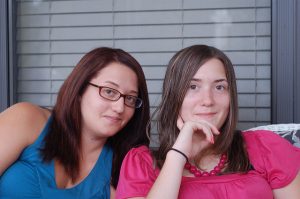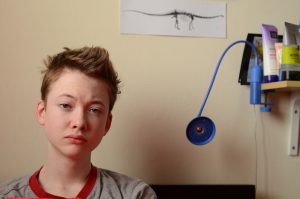
Anorexia nervosa has a death rate that is one of the highest of any clinically defined mental illness. In a recent meta-analysis (a review bringing together the results of lots of studies) the standardised mortality rate (ratio of observed deaths in a population compared to the expected deaths in the overall population) was 5.86 for people with anorexia nervosa (Arcelus et al, 2011).
Given that the median age of onset of anorexia nervosa is 12 to 13 years, this seems like the sort of thing you’d want to do something about. Or given that it’s an illness associated with suffering as well as a high mortality rate. There are currently lots of givens, but not enough effective treatment.
Current evidence seems to indicate that families can play a role in supporting successful treatment outcomes for adolescents with anorexia nervosa. It is not known whether this is through providing valuable support or by addressing any causes of anorexia that are potentially rooted in family interactions. Regardless of its mechanism of action, there have been few randomised controlled trials for treatments for adolescents with anorexia nervosa. The majority of the clinical trials that do exist demonstrate that involving family members in treatment often supports more favourable outcomes than treatments with no family involvement.
The family that does therapy together, helps one member of that family achieve positive health outcomes together, although that family may have been the cause of the original problems, it’s difficult to say sometimes. This probably won’t catch on as a saying.

Current evidence seems to indicate that families can play a role in supporting successful treatment outcomes for adolescents with anorexia nervosa.
Family-based treatment proceeds through several phases of treatment, including weight-restoration, returning control over eating to the adolescent and establishing healthy identity for the adolescent; all with involvement of the adolescent’s family. It has been shown to obtain average rates of symptom remission of 34% at the end of treatment, 40% at 12-month follow-up and 33% at 4-year follow-up (Forsberg & Lock, 2015).
Remission here is defined as a Body Mass Index at least 95% of average (median) and an Eating Disorder Examination Global score within one standard deviation of community norms. The Eating Disorder Examination is a standardised interview intended to determine the severity of an eating disorder. This isn’t a list that’s getting shorter though. There are quite a few ways of scoring various mental illnesses and it’s important to standardise these elaborate ways of asking people, “how are you?”.
Additional studies have shown these rates of remission achieved by family-based treatment can be increased to above 50% by adding three sessions of parent counselling sessions. In the parent-focused treatment model, in a display of imaginative naming convention, it is primarily the parents of adolescents with anorexia nervosa who are the focus of treatment. The clinician works only with the parents during treatment sessions, while a nurse provides support to their child (in this setting an adolescent with anorexia nervosa), monitoring their mental and medical condition.
During parent-focused therapy, the adolescent with anorexia nervosa attends a 15 minute session with the nurse before the parent’s or parents’ session with the therapist. Any pertinent information from the adolescent’s session with the nurse is past onto the therapist when they see the parents for 50 minutes. The therapeutic content of these sessions is the same as in family-based treatment.
The family that does therapy separately, helps one member of that family achieve positive health outcomes separately, although that family may have been the cause of the original problems, it’s difficult to say sometimes. This probably won’t catch on as a saying.
This randomised controlled trial (RCT) compared the effectiveness of family-based treatment and parent-focused treatment for adolescents with anorexia nervosa (Le Grange et al, 2016). The authors’ hypothesis was that parent-focused therapy would be more effective than family-based treatment as demonstrated by higher remission rates at the end of the treatment period.

This RCT compared family-based treatment with parent-focused treatment for young people with anorexia.
Methods
106 people aged 12–18 years who met the DSM-IV criteria for anorexia nervosa or partial anorexia nervosa were randomised to receive family-based treatment or parent-focused treatment.
Five psychologists and three social work clinicians delivered the therapies, and three registered nurses were responsible for the adolescents’ parent-focused treatment sessions.
Each treatment comprised 18 outpatient sessions over the course of 6 months. Individuals were considered to have completed a treatment if they attended at least 9 sessions i.e. 50%. It’s a good job the treatment wasn’t an antibiotic.
The study took place as part of a specialist paediatric eating disorders programme within a tertiary public hospital. All people who presented to the specialist clinic during the recruitment period (July 2010 to July 2014) were assessed for their eligibility to be included in the study.
Inclusion criteria
To be included, the adolescents had to meet the DSM-IV criteria for diagnosis with anorexia nervosa (excluding the amenorrhea criteria), be aged 12–18 years and be living with at least one parent who was available to undertake treatment. In summary, they had to be an adolescent with anorexia nervosa who could take part in family-based/parent focused treatment.
Exclusion criteria
Adolescents with medical instability (as defined by the American Academy of Pediatrics), current psychotic disorder or alcohol dependence, acute suicidality, a physical condition that influenced eating or weight, previous family-based treatment for anorexia nervosa or been receiving a psychotropic medication for less than 8 weeks could not be included in the study. That might be too complicated.
Follow-up
Interviews with the adolescents and parents were completed at baseline (start of the study), at the end of treatment, and at 6 and 12 months after treatment. Questionnaires were completed twice a week for the first 3 months of treatment and at each interview assessment.
Outcomes
The main outcome of interest (the primary outcome) was remission of anorexia nervosa. This was defined as a Body Mass Index at least 95% of average (median) and an Eating Disorder Examination Global Score within one standard deviation of community norms.
Results
The Participants
- Mean age: 15.5 years (standard deviation: 1.5)
- Female: 87.7%
- Mean percent Body Mass Index: 81.9% (standard deviation: 6.1)
- Mean duration of illness: 10.5 months (standard deviation: 8.8)
There were no significant differences between the group receiving patient-focused treatment and the group receiving family-based treatment.
The Treatments
84.9% of participants completed treatment (86.3% in parent-focused treatment and 83.6% in family-based treatment).
Remission was significantly higher for parent-focused therapy compared with family-based therapy (43% vs. 22%; p=0.016; OR=3.03; CI= 1.23 to 7.46) at the end of the treatment period.
There was no significant difference between the two therapy groups for remission at 6-month or 12-month follow-up.
There was no significant difference between the two therapy groups for any of the secondary outcome measures.
From the Eating Disorder Examination questionnaire and the Yale-Brown-Cornell Eating Disorder Scale, respectively, eating disorder psychopathology and eating disorder-related obsessions and compulsions were moderators of treatment outcomes at 6 and 12 months of follow up. People with more severe eating disorder psychopathology did as well with either treatment, while those with more eating disorder-related obsessions and compulsions tended to do better with family-based treatment.

Remission was significantly higher for parent-focused therapy compared with family-based therapy at the end of the treatment period.
Authors’ conclusions
At the end of the treatment period, parent-focused therapy was more effective than family-based therapy in bringing about remission of anorexia nervosa symptoms in adolescents. However, these differences were not statistically significant at follow-up.
Strengths and limitations
The authors noted several advantages of this study, including a relatively large study population, the inclusion of therapists who were specifically trained in family-based interventions, the use of independent assessors to examine treatment outcomes and a relatively low study drop-out rate.
To be honest, the mere existence of this trial is an advantage. The current study is now only the seventh RCT to examine family interventions for adolescents with anorexia nervosa. Given that there is a lack of effective treatment for adolescents with anorexia nervosa, the presence of large, well-designed trials demonstrating that some treatments can work is very much needed.
The authors also noted several potential limitations, including the loss of follow-up data by 12 months and the fact that this study took place in a specialist setting, which may limit the application of any findings to more general treatment settings. On a more mathematical note, the authors also noted that the exploratory analysis of potential moderators of treatment outcome did not adjust for multiple comparisons. This would mean that they were more likely to incorrectly find that something was a potential moderator of treatment outcome. As such, these results should be treated with caution, i.e. not really believed.
The finding that parent-focused treatment was more effective than family-based treatment at the end of treatment indicates only that parent-focused treatment is more efficient in obtaining symptom remission than family-based treatment. This is a good thing, although some care should be taken that weight gain isn’t too rapid in people with anorexia nervosa. However, there were no differences in the long term, which is ultimately where people have to live. It seems that if you want an adolescent with anorexia nervosa to improve slightly more quickly, then parent-focused treatment is the best option. If you want them to improve overall in the long term, either will do, but better treatments are needed.
In addition, the rates of remission weren’t that great, although they may be the best that can currently be achieved. For parent-focused therapy, 43% of people achieved remission at the end of therapy, 39% at 6-months follow-up and 37% 12 months follow-up. This is slightly worse than finding out that tails is a form of treatment, and flipping a coin for every patient. More work is evidently needed to improve the effectiveness of parent-focused and family-based treatments. This may be through combining it with other treatments. After all, an original finding for family-based treatment was that remission rates were improved to over 50% with the ADDITION of parental counselling.
Finally, it’s probably a semantic argument, but parent-focused treatment appears to be moving the focus away from the person with the problem, the adolescent with anorexia nervosa. If this method is shown to work and helps the affected adolescents regain a healthy weight and improve their thoughts around eating, then fine. However, there does seem to be a slight shift in power with parent-focused treatment that should be considered.

Overall, remission rates weren’t that great, and we urgently need better treatments for young people with eating disorders.
Summary
For adolescents with anorexia nervosa, parent-focused treatment appears to be more efficient than family-based treatment in improving weight and symptoms over a 6 month period. However, there is no difference between the treatments 6 and 12 months later. More effective treatments are needed, and if it works, we must remember that at the centre of it all is a young person who cannot and should not be ignored.
Won’t somebody please think of the “children”? This probably won’t catch on as a saying.
Links
Primary paper
Le Grange D, et al. (2016) Randomized Clinical Trial of Parent-Focused Treatment and Family-Based Treatment for Adolescent Anorexia Nervosa. J Am Acad Child Adolesc Psychiatry 2016; doi: http://dx.doi.org/10.1016/j.jaac.2016.05.007. [Epub ahead of print].
Other references
Arcelus J, et al. (2011) Mortality rates in patients with anorexia nervosa and other eating disorders. A meta-analysis of 36 studies. Arch Hen Psychiatry 2011;68(7):724–31. [PubMed].
Forsberg A & Lock J. (2015) Family-based treatment of child and adolescent eating disorders. Child Adolesc Psychaitr Clin N Am 2015;24(3):617–29. [PubMed].
Woerwag-Mehta S & Treasure J. Causes of anorexia nervosa. Psychiatry 2008;7(4):147–51.

Parent-focused treatment for anorexia in adolescents: more efficient than… https://t.co/H37xlc9HuT #MentalHealth https://t.co/qXtrTXif87
Parent-focused vs family-based treatment for anorexia in adolescents. More efficient? https://t.co/h66JDYBesX Me for that @Mental_Elf
Today @hullodave on new RCT comparing family-based treatment with parent-focused treatment for #anorexia https://t.co/Secw7HF9Q3
Parent-focused treatment vs family-based treatment
For anorexia in young people
We report on new RCT
https://t.co/Secw7HF9Q3
Trial of family-based vs parent-focused treatment for #anorexia says parent-focused is more efficient. Make sense? https://t.co/h66JDYBesX
#Parent-focused treatment for #anorexia in adolescents: more efficient than family-based treatment says new #RCT https://t.co/xuRmaNqZG3
I summarised a new trial of family-based vs parent-focused treatment for anorexia https://t.co/h66JDYBesX If that’s what you’re in to.
Evidence suggests that families can play a role in supporting successful treatment for adolescents with anorexia https://t.co/Secw7HF9Q3
Family-based or parent-focused therapy for adolescents with anorexia. You decide!* https://t.co/h66JDYBesX
*A trial decides**
**@Mental_Elf
RT @Mental_Elf: We urgently need better treatments for young people with eating disorders https://t.co/3HcHPZ8Dy0 https://t.co/kViX7lr87m
interesting blog on treatment of anorexia on @Mental_Elf here: https://t.co/RUKxaS4WII
But which is better? There’s only one way to find out.
Randomised controlled trial!
https://t.co/h66JDYBesX
By Me for @Mental_Elf
@hullodave @Mental_Elf https://t.co/ND2BsVZ7LL
Don’t miss: Parent-focused treatment for anorexia: more efficient than family-based treatment, says new RCT https://t.co/Secw7HF9Q3 #EBP
@Mental_Elf https://t.co/ND2BsVZ7LL
Parent-focused vs family-based treatment for adolescents with anorexia. Some evidence. https://t.co/h66JDYBesX Me for @Mental_Elf
[…] Steele (Steele, 2016) reviewed a randomised controlled trial of a parent training programme for adolescent anorexia. On this occasion parent training was not shown to have a significant […]
[…] approaches for adolescent eating disorders is to be welcomed, a point made by David Steele in this parent-focused treatment blog in 2016. His blog excellently identifies some of the problems with an RCT suggesting that family […]